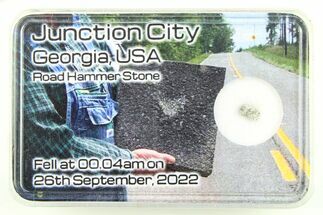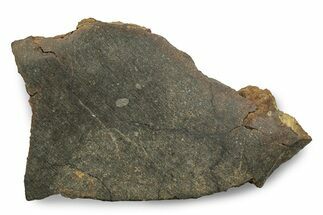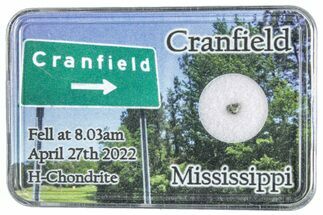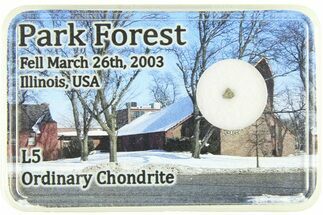This Specimen has been sold.
.2" Murchison Chondrite Meteorite (0.29 g) Fragment - Australia
This is an incredibly rare specimen: a .2" wide (0.29 gram) fragment of the Murchison meteorite, a witnessed fall over the town of Murchison in Victoria, Australia on September 28, 1969. It fell as a meteor shower over about a 5-square-mile area. The total mass is about 1,000 kilograms; the largest piece fell through a barn roof!
Murchison is classified as a CM chondrite, a rare kind of primitive chondrite with fine-grained chondrules and matrices as well as abundant hydrated minerals. Some silicon carbide particles contained within this meteorite date to over 7 billion years old, making this perhaps the oldest material ever known. It even contains organic compounds, including amino acids!
This meteorite is highly prized for both its rarity and scientific value; take home this astronomical find today!
Murchison is classified as a CM chondrite, a rare kind of primitive chondrite with fine-grained chondrules and matrices as well as abundant hydrated minerals. Some silicon carbide particles contained within this meteorite date to over 7 billion years old, making this perhaps the oldest material ever known. It even contains organic compounds, including amino acids!
This meteorite is highly prized for both its rarity and scientific value; take home this astronomical find today!
About CM2 Carbonaceous Chondrites
Carbonaceous chondrites are a rare and scientifically significant type of stony meteorite, representing only about 4% of all meteorites found on Earth. These meteorites are considered to be some of the oldest materials in the solar system, dating back over 4.5 billion years. They are composed primarily of silicate minerals but are unique for their high levels of carbon, organic compounds, and water-bearing minerals, offering a glimpse into the conditions of the early solar system.
Theys are divided into several groups, including CI, CM, CR, CO, CV, and CK, each representing different compositions and histories. CI and CM chondrites are the most primitive and are often rich in organic compounds. CI chondrites, like the Orgueil meteorite, are extremely rare and contain the highest known concentrations of organic materials among meteorites.
A CM2 chondrite is a type of carbonaceous chondrite meteorite with a high abundance of carbon and water-bearing minerals. The “CM” classification stands for the "Mighei-type," named after a meteorite that fell in Mighei, Ukraine. The "2" in CM2 indicates a specific petrologic (textural) type, meaning it has experienced low levels of alteration from water or heat compared to other chondrites, preserving more primitive materials.
Carbonaceous chondrites are a rare and scientifically significant type of stony meteorite, representing only about 4% of all meteorites found on Earth. These meteorites are considered to be some of the oldest materials in the solar system, dating back over 4.5 billion years. They are composed primarily of silicate minerals but are unique for their high levels of carbon, organic compounds, and water-bearing minerals, offering a glimpse into the conditions of the early solar system.
Theys are divided into several groups, including CI, CM, CR, CO, CV, and CK, each representing different compositions and histories. CI and CM chondrites are the most primitive and are often rich in organic compounds. CI chondrites, like the Orgueil meteorite, are extremely rare and contain the highest known concentrations of organic materials among meteorites.
A CM2 chondrite is a type of carbonaceous chondrite meteorite with a high abundance of carbon and water-bearing minerals. The “CM” classification stands for the "Mighei-type," named after a meteorite that fell in Mighei, Ukraine. The "2" in CM2 indicates a specific petrologic (textural) type, meaning it has experienced low levels of alteration from water or heat compared to other chondrites, preserving more primitive materials.
TYPE
Carbonaceous Chondrite (CM2)
LOCATION
Murchison, Victoria, Australia
SIZE
.2" wide, 0.29 grams
CATEGORY
ITEM
#266099
 Reviews
Reviews












